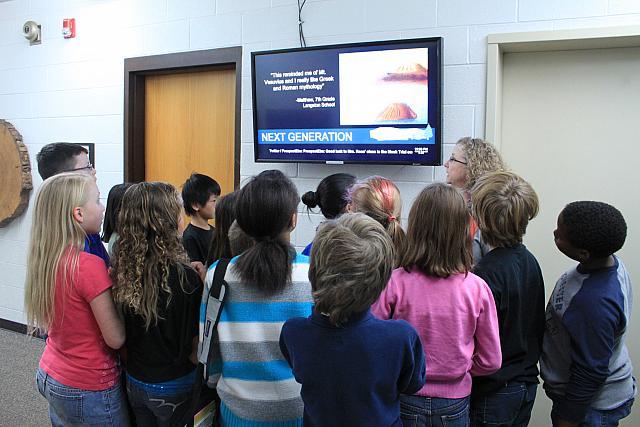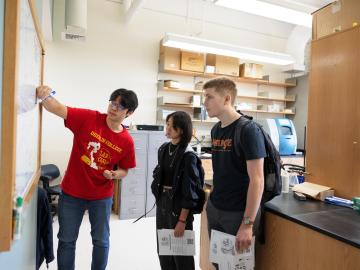Ohio EPA Grant Brings Environmental Dashboard Lessons to Urban School Districts
December 20, 2016
Communications Staff

OBERLIN—The college has received a $49,689 grant from the Ohio EPA’s Ohio Environmental Education Fund (OEEF) for a pilot project to provide curricular development and teacher training in four Ohio school districts that have already installed or plan to install Environmental Dashboard technology.
Developed at Oberlin College with EPA support, the Environmental Dashboard makes flows of water and energy through buildings and whole communities and environmental conditions visible, engaging and teachable, while also linking these to smart environmental decision-making. The dashboard combines real-time feedback with “Community Voices” to draw attention to positive actions of youth and community members who are already working to build more resilient and sustainable communities.
An Oberlin team will coordinate curricular integration in Akron Public Schools, the Cleveland Metropolitan School District (CMSD), and Toledo Public Schools. Oberlin City Schools, which piloted curricular integration of the Environmental Dashboard with earlier grants, will play a leadership role. The pilot will lay the groundwork for expansion within and beyond these districts.
The grant will support teacher workshops, which will create expertise in Environmental Dashboard technology and engage educators in developing and testing lessons that emphasize authentic and active student learning experiences and community engagement. Resulting instructional units will follow best practices, be aligned with learning goals and standards, and will be hosted on a searchable database accessible to the growing number of schools using dashboard technology.
Partly in response to the successful OEEF-funded Oberlin pilot, the dashboard is proliferating in northeast Ohio. In spring 2015, dashboard technology to monitor electricity was installed in all 42 Toledo public schools. In summer 2015, dashboard monitoring was installed in four Akron public schools. And in June 2016, the Cleveland Metropolitan School District committed to installing the dashboard to monitor and display electricity, water, and gas use in nine STEM-focused schools.
In Cleveland, the dashboard will be used in a cross-section of schools, including a dual language K-8 school, a career tech high school, and several K-8 STEM schools.
“Since fall 2011, the CMSD Department of Science Education has focused on incorporating environmental science at all grade levels in all schools. We feel that environmental science aligns with Ohio’s Learning Standards for Science, increases opportunities for experiential learning and provides real world application of scientific skills and processes,” says Kirsten Mahovlich, CMSD’s curriculum and instruction content manager for science, grades 7-12.
The pilot continues CMSD’s efforts to accelerate engagement in innovative and authentic learning experiences where students investigate global issues through the lens of their community, and the real-time data will connect students to problems that are multifaceted, says Tim Sisson, the CMSD’s STEM content manager.
“The Environmental Dashboard is the next element of the STEM learning matrix the district has been striving to create for the last five years,” Sisson says. “This matrix includes initiatives with local education partners, including Cuyahoga Valley Environmental Education Center, Natural History Museum, Metroparks Zoo, Cleveland Aquarium and the Nature Center at Shaker Lakes, along with WKYC supported weather stations and the district’s pK-8 STEM- focused efforts. The matrix provides scholars a connected learning experience where they author their learning and develop their own knowledge matrix leading to deeper learning and meaning for applications in life.”
For more than a decade the Oberlin community—both college and city—have served as a pilot for developing Environmental Dashboard as a technology and an approach. “For several years we have been working with educators in the Oberlin City Schools, and it is exciting to now be engaging with large urban districts which obviously have their own distinct challenges and opportunities,” says John Petersen, creator of the dashboard and Oberlin’s Paul Sears Professor of Environmental Studies and Biology. “Using the technology to help students see themselves as connected and empowered decision-makers within their schools and communities is critical at all scales.
As part of the project, Palmer Conservation Consulting, an energy consulting firm headquartered in Toledo, is working with participating Akron and Cleveland schools to complete meter installation and configuration of the building dashboards.
The Oberlin dashboard team includes Petersen along with Cindy Frantz, professor of psychology; Rumi Shammin, associate professor and director of the environmental studies program; Augustus Arthur, project manager of the Environmental Dashboard; and Darrel Tremaine, Oberlin’s sustainable technology coordinator.
Tags:
You may also like…
The Impact of Collective Action
March 27, 2025
How our work as a community helped us achieve carbon neutrality.
Oberlin’s Sustainable Infrastructure Program Reaches Major Milestone
December 4, 2024
Geothermal heating and cooling system comes online, supports Oberlin reaching 100 percent carbon neutrality by 2025.
Friday Afternoon with Lab Crawl
October 30, 2023
This year’s Lab Crawl drew what may be the largest crowd in the event’s illustrious history, with some 500 students and dozens of faculty taking part. Missed out on the excitement? It looked something like this.


